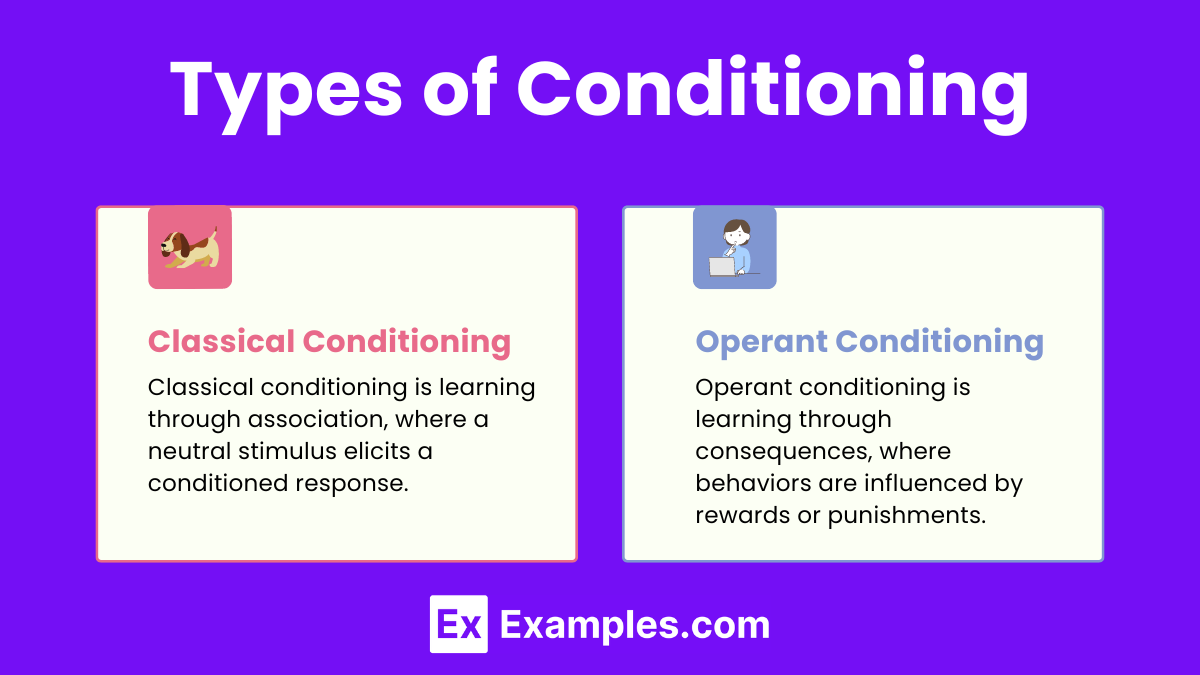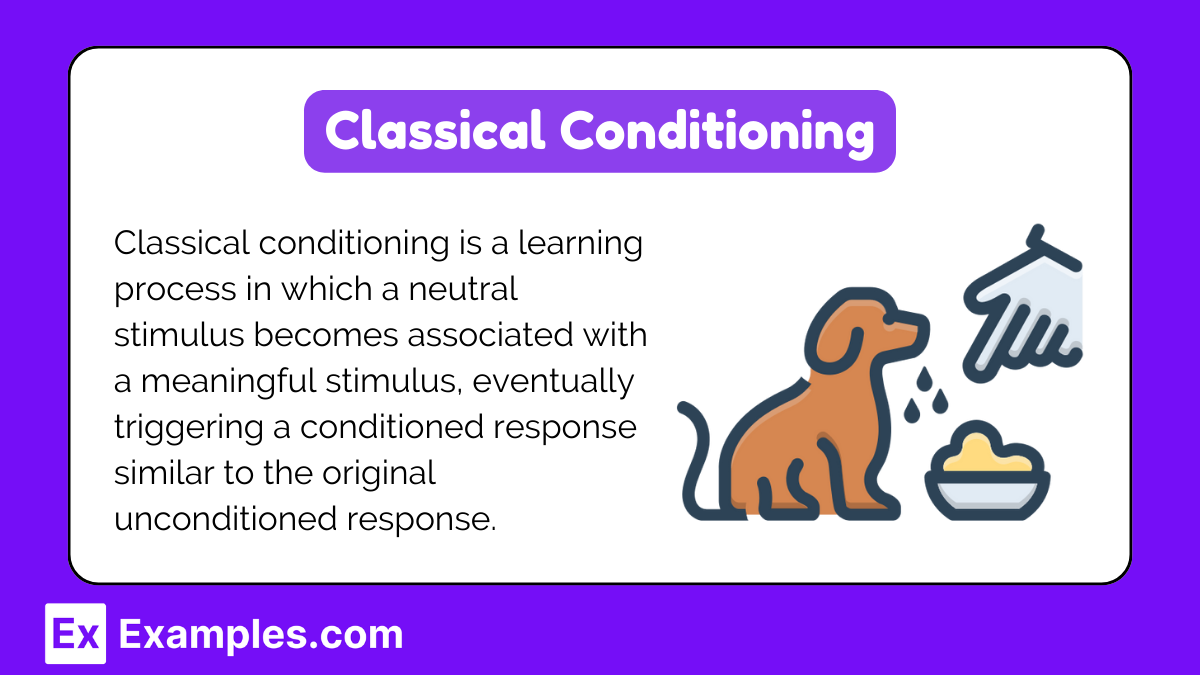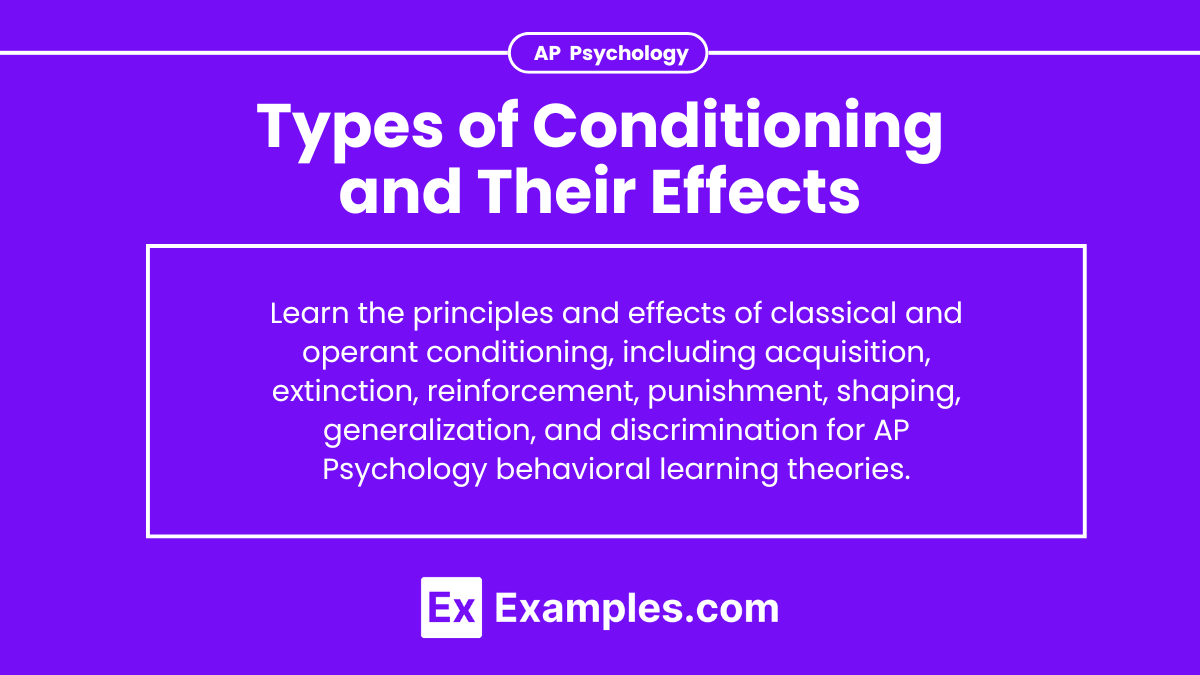In understanding the types of conditioning and their effects, AP Psychology focuses on grasping behavioral learning theories. Classical conditioning involves learning through association, where a neutral stimulus becomes linked to a meaningful stimulus, eliciting a conditioned response. Operant conditioning focuses on how behaviors are influenced by their consequences, with reinforcement increasing desired behaviors and punishment decreasing undesired behaviors. Mastering these concepts will help analyze various psychological experiments and real-life applications of behavioral learning.
Learning Objectives
Focus on understanding the principles and applications of classical and operant conditioning. Learn the key components of classical conditioning, including unconditioned stimulus, unconditioned response, conditioned stimulus, and conditioned response. Study the types of operant conditioning: positive reinforcement, negative reinforcement, positive punishment, and negative punishment. Recognize the effects of these conditioning types on behavior, and be able to apply these concepts to real-life scenarios and psychological experiments. Understanding these will be crucial for analyzing behavioral learning theories.
Types of Conditioning

Conditioning is a fundamental concept in psychology that explains how behaviors can be learned or modified. There are two primary types of conditioning: classical conditioning and operant conditioning. Each type has distinct mechanisms and effects on behavior.
Classical Conditioning

Classical conditioning, also known as Pavlovian conditioning, involves learning through association. This type of conditioning was first described by Ivan Pavlov, a Russian physiologist.
Key Concepts
- Unconditioned Stimulus (US): A stimulus that naturally and automatically triggers a response. For example, food triggers salivation in dogs.
- Unconditioned Response (UR): The unlearned response that occurs naturally in reaction to the unconditioned stimulus. For instance, salivation in response to food.
- Conditioned Stimulus (CS): A previously neutral stimulus that, after being paired with the unconditioned stimulus, begins to trigger a conditioned response.
- Conditioned Response (CR): The learned response to the previously neutral stimulus. After conditioning, the dog salivates when hearing a bell if the bell was repeatedly paired with food.
Phases of Classical Conditioning
- Acquisition: The initial stage where the neutral stimulus is paired with the unconditioned stimulus. This is when the association is formed.
- Extinction: The diminishing of a conditioned response when the conditioned stimulus is no longer paired with the unconditioned stimulus.
- Spontaneous Recovery: The reappearance of a weakened conditioned response after a pause, indicating that extinction is not permanent.
- Generalization: The tendency to respond to stimuli similar to the conditioned stimulus.
- Discrimination: The learned ability to distinguish between the conditioned stimulus and other stimuli that do not signal an unconditioned stimulus.
Effects of Classical Conditioning
- Acquisition: This is the initial stage where the neutral stimulus becomes associated with the unconditioned stimulus, leading to a conditioned response. For example, Pavlov’s dogs began to salivate when they heard a bell because they associated it with food.
- Extinction: If the conditioned stimulus is repeatedly presented without the unconditioned stimulus, the conditioned response gradually diminishes. For instance, if the bell is rung without presenting food, the dogs will eventually stop salivating.
- Spontaneous Recovery: After a period of extinction, the conditioned response can reappear if the conditioned stimulus is presented again. This shows that the learning was not completely lost.
- Generalization: This occurs when stimuli similar to the conditioned stimulus also elicit the conditioned response. For example, a dog conditioned to salivate to a bell may also salivate to similar sounds.
- Discrimination: The ability to distinguish between the conditioned stimulus and other similar stimuli. This means the conditioned response occurs only with the specific conditioned stimulus and not others.
Operant Conditioning

Operant conditioning, also known as instrumental conditioning, involves learning through consequences. This type of conditioning was developed by B.F. Skinner, an American psychologist.
Key Concepts
- Reinforcement: Any event that strength or increases the frequency of a behavior.
- Positive Reinforcement: Adding a pleasant stimulus to increase a behavior (e.g., giving a treat to a dog for sitting).
- Negative Reinforcement: Removing an unpleasant stimulus to increase a behavior (e.g., turning off a loud noise when a rat presses a lever).
- Punishment: Any event that weakens or decreases the frequency of a behavior.
- Positive Punishment: Adding an unpleasant stimulus to decrease a behavior (e.g., spanking a child for misbehaving).
- Negative Punishment: Removing a pleasant stimulus to decrease a behavior (e.g., taking away a toy when a child misbehaves).
Schedules of Reinforcement
- Continuous Reinforcement: Providing reinforcement every time a behavior occurs. This leads to rapid learning but also rapid extinction.
- Partial (Intermittent) Reinforcement: Providing reinforcement only part of the time. This leads to slower learning but greater resistance to extinction.
- Fixed-Ratio (FR) Schedule: Reinforcement after a set number of responses (e.g., every 5th response).
- Variable-Ratio (VR) Schedule: Reinforcement after an unpredictable number of responses (e.g., gambling).
- Fixed-Interval (FI) Schedule: Reinforcement after a fixed amount of time (e.g., paycheck every two weeks).
- Variable-Interval (VI) Schedule: Reinforcement after varying time intervals (e.g., pop quizzes).
Effects of Operant Conditioning
Reinforcement:
- Positive Reinforcement: Adding a desirable stimulus to increase a behavior. For example, giving a treat to a dog for sitting increases the likelihood of the dog sitting again.
- Negative Reinforcement: Removing an aversive stimulus to increase a behavior. For instance, taking painkillers to relieve a headache reinforces the behavior of taking medication.
Punishment:
- Positive Punishment: Adding an aversive stimulus to decrease a behavior. For example, scolding a child for misbehaving reduces the likelihood of the misbehavior recurring.
- Negative Punishment: Removing a desirable stimulus to decrease a behavior. For instance, taking away a teenager’s video game privileges for breaking curfew reduces the likelihood of breaking curfew again.
Shaping: Gradually reinforcing behaviors that lead up to the desired behavior. For example, training a dog to roll over by rewarding successive steps, like lying down, then turning onto its back, and finally completing the roll.
Extinction: When reinforcement is no longer provided, the learned behavior gradually diminishes. For example, if a vending machine stops dispensing snacks, people will eventually stop using it.
Generalization: The tendency to respond in the same way to different but similar stimuli. For instance, a student rewarded for good behavior in one class may generalize that behavior to other classes.
Discrimination: Learning to respond only to a specific stimulus and not to similar stimuli. For example, a rat in a Skinner box learns to press a lever only when a green light is on, not when a red light is on.


